席夫碱多核金属配位化学3
- 格式:ppt
- 大小:1.31 MB
- 文档页数:18
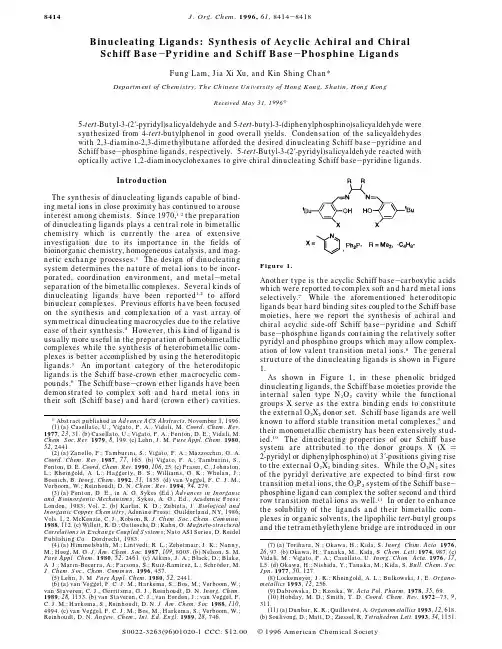
Binucleating Ligands:Synthesis of Acyclic Achiral and Chiral Schiff Base-Pyridine and Schiff Base-Phosphine LigandsFung Lam,Jia Xi Xu,and Kin Shing Chan*Department of Chemistry,The Chinese University of Hong Kong,Shatin,Hong KongReceived May31,1996X5-tert-Butyl-3-(2′-pyridyl)salicyaldehyde and5-tert-butyl-3-(diphenylphosphino)salicyaldehyde were synthesized from4-tert-butylphenol in good overall yields.Condensation of the salicyaldehydes with2,3-diamino-2,3-dimethylbutane afforded the desired dinucleating Schiff base-pyridine and Schiff base-phosphine ligands,respectively.5-tert-Butyl-3-(2′-pyridyl)salicyaldehyde reacted with optically active1,2-diaminocyclohexanes to give chiral dinucleating Schiff base-pyridine ligands.IntroductionThe synthesis of dinucleating ligands capable of bind-ing metal ions in close proximity has continued to arouseinterest among chemists.Since1970,1,2the preparationof dinucleating ligands plays a central role in bimetallicchemistry which is currently the area of extensiveinvestigation due to its importance in the fields ofbioinorganic chemistry,homogeneous catalysis,and mag-netic exchange processes.3The design of dinucleatingsystem determines the nature of metal ions to be incor-porated,coordination environment,and metal-metal separation of the bimetallic complexes.Several kinds of dinucleating ligands have been reported1,2to afford binuclear complexes.Previous efforts have been focused on the synthesis and complexation of a vast array of symmetrical dinucleating macrocycles due to the relative ease of their synthesis.4However,this kind of ligand is usually more useful in the preparation of homobimetallic complexes while the synthesis of heterobimetallic com-plexes is better accomplished by using the heteroditopic ligands.5An important category of the heteroditopic ligands is the Schiff base-crown ether macrocyclic com-pounds.6The Schiff base-crown ether ligands have been demonstrated to complex soft and hard metal ions in their soft(Schiff base)and hard(crown ether)cavities.Another type is the acyclic Schiff base-carboxylic acids which were reported to complex soft and hard metal ions selectively.7While the aforementioned heteroditopic ligands bear hard binding sites coupled to the Schiff base moieties,here we report the synthesis of achiral and chiral acyclic side-off Schiff base-pyridine and Schiff base-phosphine ligands containing the relatively softer pyridyl and phosphino groups which may allow complex-ation of low valent transition metal ions.8The general structure of the dinucleating ligands is shown in Figure 1.As shown in Figure1,in these phenolic bridged dinucleating ligands,the Schiff base moieties provide the internal salen type N2O2cavity while the functional groups X serve as the extra binding ends to constitute the external O2X2donor set.Schiff base ligands are well known to afford stable transition metal complexes,9and their monometallic chemistry has been extensively stud-ied.10The dinucleating properties of our Schiff base system are attributed to the donor groups X(X) 2-pyridyl or diphenylphosphino)at3′-positions giving rise to the external O2X2binding sites.While the O2N2sites of the pyridyl derivative are expected to bind first row transition metal ions,the O2P2system of the Schiff base-phosphine ligand can complex the softer second and third row transition metal ions as well.11In order to enhance the solubility of the ligands and their bimetallic com-plexes in organic solvents,the lipophilic tert-butyl groups and the tetramethylethylene bridge are introduced in ourX Abstract published in Advance ACS Abstracts,November1,1996.(1)(a)Casellato,U.;Vigato,P.A.;Vidali,M.Coord.Chem.Rev. 1977,23,31.(b)Casellato,U.;Vigato,P.A.;Fenton,D.E.;Vidali,M. Chem.Soc.Rev.1979,8,199.(c)Lehn,J.M.Pure Appl.Chem.1980, 52,2441.(2)(a)Zanello,P.;Tamburini,S.;Vigato,P.A.;Mazzocchin,G.A. Coord.Chem.Rev.1987,77,165.(b)Vigato,P.A.;Tamburini,S.; Fenton,D.E.Coord.Chem.Rev.1990,106,25.(c)Fraser,C.;Johnston, L.;Rheingold,A.L.;Haggerty,B.S.;Williams,G.K.;Whelan,J.; Bosnich,B.Inorg.Chem.1992,31,1835.(d)van Veggel,F.C.J.M.; Verboom,W.;Reinhoudt,D.N.Chem.Rev.1994,94,279.(3)(a)Fenton,D.E.,in A.G.Sykes(Ed.)Advances in Inorganic and Bioinorganic Mechanisms;Sykes,A.G.,Ed.;Academic Press: London,1983;Vol.2.(b)Karlin,K.D.;Zubieta,J.Biological and Inorganic Copper Chemistry;Adenine Press:Guilderland,NY,1986; Vols.1,2.McKenzie,C.J.;Robson,R.J.Chem.Soc.,mun. 1988,112.(c)Willett,R.D.;Gatteschi,D.;Kahn,O.Magneto-structural Correlations in Exchange Coupled Systems;Nato ASI Series,D.ReidelPublishing Co.:Dordrecht,1983.(4)(a)Himmelsbath,M.;Lintvedt,R.L.;Zehetmair,J.K.;Nanny, M.;Heeg,M.G.J.Am.Chem.Soc.1987,109,8003.(b)Nelson,S.M. Pure Appl.Chem.1980,52,2461.(c)Atkins,J.A.;Black,D.;Blake, A.J.;Marin-Becerra,A.;Parsons,S.;Ruiz-Ramirez,L.;Schro¨der,M. J.Chem.Soc.,mun.1996,457.(5)Lehn,J.M.Pure Appl.Chem.1980,52,2441.(6)(a)van Veggel,F.C.J.M.;Harkema,S.;Bos,M.;Verboom,W.; van Staveren,C.J.;Gerritsma,G.J.;Reinhoudt,D.N.Inorg.Chem. 1989,28,1133.(b)van Staveren,C.J.;van Eerden,J.;van Veggel,F.C.J.M.;Harkema,S.;Reinhoudt,D.N.J.Am.Chem.Soc.1988,110, 4994.(c)van Veggel,F.C.J.M.;Bos,M.;Harkema,S.;Verboom,W.; Reinhoudt,D.N.Angew.Chem.,Int.Ed.Engl.1989,28,746.(7)(a)Torihara,N.;Okawa,H.;Kida,S.Inorg.Chim.Acta.1976, 26,97.(b)Okawa,H.;Tanaka,M.;Kida,S.Chem.Lett.1974,987.(c) Vidali,M.;Vigato,P.A.;Casellato,U.Inorg.Chim.Acta.1976,17, L5.(d)Okawa,H.;Nishida,Y.;Tanaka,M.;Kida,S.Bull.Chem.Soc. Jpn.1977,50,127.(8)Lockemeyer,J.R.;Rheingold,A.L.;Bulkowski,J,ano-metallics1993,12,256.(9)Dabrowska,D.;Rzoska,W.Acta Pol.Pharm.1978,35,69.(10)Hobday,M.D.;Smith,T.D.Coord.Chem.Rev.1972-73,9, 311.(11)(a)Dunbar,K.R.;Quilleve´re´,anometallics1993,12,618.(b)Soulivong,D.;Matt,D.;Ziessel,R.Tetrahedron Lett.1993,34,1151. Figure1..Chem.1996,61,8414-8418S0022-3263(96)01020-1CCC:$12.00©1996American Chemical Societyligand design.1,2-Diaminocyclohexanes,readliy avail-able chiral diamines,are employed for the synthesis of chiral ligands.The class of chiral dinucleating ligands is especiallyinteresting since the asymmetric induction coupled with bimetallic cooperativity in a multiple redox reaction for these heterobimetallic complexes would be promising biomimetics as well as potential asymmetric catalysts such as aerobic oxidation catalysts.12We now disclose our full results in the synthesis of acyclic achiral and chiral Schiff base-pyridine and achiral Schiff base-phosphine ligands.13Results and DiscussionThe dinucleating ligands7and13were prepared by the condensation of2,3-diamino-2,3-dimethylbutane and optically active1,2-diaminocyclohexanes with5-tert-butyl-3-(2′-pyridyl)salicyaldehyde and5-tert-butyl-3-(diphenylphosphino)salicyaldehyde which were synthe-sized according to Schemes1and2.As shown in Scheme1,the ligand7was synthesized from4-tert-butylphenol in four steps in50%overall yield. Formylation of4-tert-butylphenol with formaldehyde14in the presence of SnCl4afforded the salicyaldehyde2which was then brominated with Br2/AcOH15to give3-bromo-5-tert-butylsalicyaldehyde(3)in95%yield.Stille type palladium-catalyzed cross coupling16of3with2-(tri-n-butylstannyl)pyridine17in THF produced5-tert-butyl-3-(2′-pyridyl)salicyaldehyde(5)in93%yield.Condensation of5with2,3-diamino-2,3-dimethylbutane18afforded the desired dinucleating ligand7in76%yield.Similarly,ligand13was prepared by the condensation reaction with5-tert-butyl-3-(diphenylphosphino)salicy-aldehyde(11)in six steps starting from4-tert-butylphenol as shown in Scheme2.Bromination of4-tert-butylphenol (1)gave a96%yield of the dibromophenol8which was then methylated with Me2SO4to afford the dibromo-anisole9in94%yield.Lithiation of7with n-BuLi in Et2O at-78°C followed by quenching with PPh2Cl produced(3-bromo-5-tert-butyl-2-anisyl)diphenylphos-phine(10)in75%yield.9was lithiated with n-BuLi/ TMEDA in Et2O at-78°C and was subsequently quenched with anhydrous DMF to afford the o-methoxy-benzaldehyde11in70%yield.Without the addition of TMEDA,no aldehyde11was formed even though the lithiation was succcessful as evidenced by the formation of deuteriated arene upon trapping reaction with D2O. Demethylation of11with BBr3yielded the salicyaldehyde 11in80%yield which was then condensed with2,3-diamino-2,3-dimethylbutane to afford ligand13in70% yield.The enantiomeric pair of chiral acyclic pyridine ligands was prepared via the condensation of5-tert-butyl-3-(2′-pyridyl)salicyaldehyde(5)with either(R,R)-and(S,S)-1,2-diaminocyclohexanes in the form of mono(+)-tar-trates19in85and86%yield,respectively(Scheme3).16 and17showed equal but opposite sign of optical rotation confirming their enantiomeric relationship.The characteristic functionalities of Schiff base ligands include the hydrogen bonded hydroxyl groups and the azomethine groups(-C d N-).These functional groups were identified in7,13,16,and17by comparing the spectroscopic data with literature values of similar systems.1a,6Broad peaks were observed in the range 3600-2400cm-1in their IR spectra which strongly suggested the presence of hydrogen bonded OH groups. Low field broad singlets appeared atδ14.76,14.37,14.14, and14.14in the1H NMR spectra of7,13,16,and17 respectively,and supported hydrogen bonded phenolic protons.In the IR spectra of these compounds,strong(12)For leading references:Larrow,J.F.;Jacobsen,E.N.J.Am. Chem.Soc.1994,116,12919.(13)Lam,F.;Chan,K.S.Tetrahedron Lett.1996,35,2439.(14)Casiraghi,G.;Casnati,G.;Puglia,G.;Sartori,G.;Terenghi,G. J.Chem.Soc.Perkin Trans.11980,1862.(15)Wriede,U.;Fernandez,M.;West,K.F.;Harcourt,D.;Moore,.Chem.1987,52,4485.(16)Stille,J.K.Angew.Chem.,Int.Ed.Engl.1986,25,508.(17)Jutzi,P.;Gilge,anomet.Chem.1983,246,163.(18)Sayre,R.J.Am.Chem.Soc.1955,77,6899.(19)Larrow,J.F.;Jacobsen,E.N.Gao,Y.;Hong,Y.;Nie,X.;Zepp,.Chem.1994,59,1939.Scheme1Scheme2Binucleating Ligands .Chem.,Vol.61,No.24,19968415signals at1620-1630cm-1were observed and likely arose from the C d N stretch of the imine linkage.The singlets atδ8.3-8.4in their NMR spectra,indicating the presence of azomethine protons,20substantiated the IR assignment.Compounds7and13also exhibited characteristic UV-vis spectra of Schiff base ligands.Schiff base ligands exhibit two absorption peaks at a lower energy region (>300nm).Bosnich21has made general assignments of the electronic transitions.The stronger,higher energy peak is attributed to theπfπ*transition of the azomethine chromophore while the weaker and less energetic peak is assigned to the n fπ*transition involving the promotion of the lone pair electron of azomethine nitrogen atom to the antibondingπorbital associated with the azomethine group.Both7and13 exhibited a pair of absorption bands in their electronic spectra.The strong peak at340-350nm and the less intense peak at430-440nm corresponded well to the expectedπfπ*and n fπ*transitions of Schiff base derivatives.Preliminary studies showed that both ligands16and 17formed mononuclear metal complexes with copper and nickel ions in high yields(Scheme4).Both homo and hetero binuclear complexes were prepared,and the full characterization by X ray crystallography as well as their catalytic activity are in progress.ConclusionIn conclusion,we have synthesized acyclic chiral and achiral dinucleating ligands of Schiff bases of pyridine and phosphine groups.Preliminary complexation studies show that these ligands formed heterobimetallic com-plexes with Ni and Cu.22Further studies of the bi-metallic chemistry of these ligands are in progress.Experimental SectionUV-vis spectra were recorded using CH2Cl2as the solvent. IR spectra were recorded on a FT-IR spectrophotometer as neat film on KBr plates.1H NMR spectra were recorded either at250MHz.Chemical shifts(δ)were reported in ppm downfield from internal standard tetramethylsilane,and coupling constants(J)were reported in hertz.13C Spectra were obtained at62.9or125MHz.Mass spectra(EI)were obtained at70eV,and FABMS was recorded using m-nitrobenzyl alcohol(NBA)as the matrix at National Tsing Hua University,Taiwan.Elemental analyses were performed by the Medac Ltd,Department of Chemistry,Brunel University, United Kingdom.Specific rotation were determined on a polarimeter.Unless otherwise noted,all materials were obtained from commercial suppliers and used without further purification. 2-(Tributylstannyl)pyridine(4),172,3-diamino-2,3-dimethyl-butane(6),182,6-dibromo-4-tert-butylphenol(8),232,6-dibromo-4-tert-butylanisole(9),24(R,R)-1,2-diammoniocyclohexane mono-(+)-tartrate,19and(S,S)-1,2-diammoniocyclohexane mono-(-)-tartrate salt(5)19were prepared according to the literature methods.Tetrahydrofuran(THF)and diethyl ether were distilled from sodium benzophenone ketyl immediately prior to use.Hexane was distilled over calcium chloride,and toluene was distilled from sodium.Silica gel(70-230mesh)was used for column chromatography.Thin layer chromatography was performed on Merck precoated silica gel60F254plates.All melting points were uncorrected.3-Bromo-5-tert-butyl-2-hydroxybenzaldehyde(3).To a solution of219(0.52g,2.93mmol)and sodium acetate(0.44 g,5.37mmol)in glacial acetic acid(13mL),was added bromine(0.47g,2.93mmol)in acetic acid(5mL)dropwise within0.5h.The mixture was heated at50°C for12h.The solvent was removed in vacuo,and the residue was poured into water and then extracted with dichloromethane.The organic layer was washed with Na2S2O5and NaHCO3solution and dried (MgSO4).The solvent was removed,and the crude product was purified by column chromatography using hexane/ethyl acetate(5:1)as the eluent(R f)0.70)to give pale yellow solids of15(0.71g,95%):mp81-83°C(CH2Cl2/hexane);1H NMR (CDCl3,250MHz)δ1.30(s,9H),7.48(d,1H,J)2.2Hz), 7.79(d,1H,J)2.2Hz),9.82(s,1H),11.39(s,1H);mass spectrum m/e(%relative intensity)258(M++2,35),256(M+, 35),243(100),241(100);IR(film)3600-3200,2958,1656, 1456,736,724cm-1.Anal.Calcd for C11H13BrO2:C,51.38; H,5.10.Found:C,51.20;H,5.08.3-(2′-Pyridyl)-5-tert-butyl-2-hydroxybenzaldehyde(5). Salicyaldehyde3(0.040g,0.156mmol),2-(tri-n-butylstannyl)-pyridine(0.17g,0.468mmol),and Pd(PPh3)4(0.018g,0.0156 mmol)were dissolved in anhydrous THF(5mL).The mixture was degassed by the freeze-thaw-pump method(three cycles)(20)Alyea,E.C.;Malek,A.Can.J.Chem.1975,53,939.(21)Bosnich,B.J.Am.Chem.Soc.1968,90,627.(22)Lam,F.;Wang,R.-J.;Mak,T.C.W.;Chan,K.S.J.Chem.Soc., mun.1994,2439.(23)Kajigaeshi,S.;Kakinimi,T.;Tokiyama,H.;Hirakawa,T.; Okamoto,T.Chem.Lett.1987,627.(24)Koike,K.;Murata,K.;Kosugi,K.Chem.Abstr.1991,114, 101336s.Scheme3Scheme4.Chem.,Vol.61,No.24,1996Lam et al.and then heated at100°C under nitrogen for72h.The solvent was removed at reduced pressure,and the residue was purified by column chromatography using hexane/ethyl acetate (10:1)as the eluent to give yellow solids(R f)0.20)as the product(0.037g,93%):mp89-91°C(CH2Cl2/hexane);1H NMR(CDCl3,250MHz)δ1.37(s,9H),7.30(m,1H),7.89 (td,1H,J)1.8,8.3Hz),7.90(d,1H,J)2.5Hz),7.99(d,1 H,J)8.3Hz),8.09(d,1H,J)2.5Hz),8.56(d,1H,J)4.3 Hz),10.60(s,1H)15.09(bs,1H);13C NMR(CDCl3,62.9MHz)δ31.30,34.24,119.57,120.10,122.01,124.25,127.13,129.75, 137.93,140.05,145.89,157.00,161.20,190.80;mass spectrum m/e(%relative intensity)255(M+,8),240(22),227(100),212 (56);IR(film)3600-2400,1680,1597,1480,1255cm-1.Anal. Calcd for C16H17NO2:C,75.27;H,6.71;N,5.49.Found:C, 74.89;H,6.60;N,5.42.Bis[5′-tert-butyl-3′-(2′′-pyridyl)salicylidene]-1,1,2,2-tet-ramethylethylenediamine(7).To a solution of5(0.042g, 0.165mmol)in refluxing absolute ethanol(5mL)was added slowly in20min2,3-diamino-2,3-dimethylbutane(6)(0.0096 g,0.083mmol)in absolute ethanol(5mL)to yield a yellow solution.The solution was refluxed for1h.After cooling, yellow crystals were collected by filtration.The rest of product was obtained by cooling the filtrate at0°C for several hours followed by filtration to afford totally0.037g of bright yellow solids as the product(76%):mp218-220°C(ethanol);1H NMR(CDCl3,250MHz)δ1.35(s,18H),1.41(s,12H),7.15-7.20(m,2H),7.33(d,2H,J)2.5Hz),7.69(td,2H,J)1.9,7.5Hz),7.96(d,2H,J)2.5Hz),8.05(d,2H,J)8.3Hz),8.44(s,2H),8.68(d,2H,J)4.3Hz),14.76(bs,2H);13C NMR(CDCl3,62.9MHz)δ23.63,32.14,34.77,65.82,119.67, 122.15,125.31,127.66,129.86,131.51,136.45,141.57,149.81, 156.65,158.57,162.48;mass spectrum m/e(%relative inten-sity)590(M+,11);IR(film)3600-2400,2962,1628,1598, 1469,1257cm-1;UV-vis[λmax,nm( ,L mol-1cm-1)]342(21.5×103),434(1.65×103).Anal.Calcd for C38H46N4O2‚1/2H2O: C,76.09;H,7.90;N,9.34.Found:C,76.13;H,7.85;N,9.35.(3-Bromo-5-tert-butyl-2-methoxyphenyl)diphenylphos-phine(10).To a solution of924(5.01g,15.6mmol)in anhydrous ether(20mL)under nitrogen-78°C was added n-BuLi(1.6M,10mL,16.0mmol)dropwise.The mixture was stirred for0.5h at-78°C to give a yellow solution to which PPh2Cl(3.44g,15.6mol)in anhydrous ether(10mL)was added dropwise at-78°C under nitrogen.The solution was allowed to warm up to room temperature and stirred for2h. Dilute HCl(10mL)was added to the solution at5°C.The mixture was extracted with ether,and the organic layer was collected and dried over MgSO4.After removal of solvent,a pale yellow oil was obtained.White crystals were collected by crystallization from ethanol,and the crude product from the mother liquor was purified by column chromatography using hexane/ethyl acetate(10:1)as the eluent(R f)0.70)to give totally5.0g of10(75%):mp101-103°C(CH2C2/hexane); 1H NMR(CDCl3,250MHz)δ1.08(s,9H),3,77(s,3H),6.64 (dd,1H,J)2.5,4.2Hz),7.20-7.36(m,10H),7.50(d,1H, J)2.5Hz);mass spectrum m/e(%relative intensity)428 (M++2,98),426(M+,100).IR(film)3069,2962,1474,1267 cm-1.Anal.Calcd for C23H24BrOP:C,64.65;H, 5.66. Found:C,64.95;H,5.69.5-tert-Butyl-3-(diphenylphosphino)-2-methoxybenzal-dehyde(11).To a well-stirred solution of10(2.94g,6.9 mmol)and TMEDA(1.04g,9.0mmol)in anhydrous ether(10 mL)at-78°C was added n-BuLi(1.6M,4.4mL,7.0mmol) dropwise under nitrogen.The orange solution was stirred at -78°C for1h.Distilled DMF(2.52g,34.5mmol)was added to the solution via a syringe at-78°C under nitrogen.The mixture was allowed to warm up to room temperature and stirred for2h.Dilute HCl was slowly added to the reaction mixture until pH)2.After stirring for1-2h,the mixture was extracted with dichloromethane,and the organic layer was dried(Na2SO4)to afford yellow oil after removal of solvent. The crude product was purified by column chromatography (hexane/ethyl acetate)10:1)to give white solids of22(1.82 g,70%):R f)0.55;mp125-126°C(CH2Cl2/hexane);1H NMR (CDCl3,250MHz)δ1.10(s,9H),3.86(s,3H),7.01(m,1H), 7.24-7.35(m,10H),7.82(d,1H,J)2.3Hz),10.35(s,1H); MS m/e(relative intensity)376(M+,88),348(97),185(14);IR(film)2963,1687,1586,1247cm-1.Anal.Calcd for C24H25O2P:C,76.58;H,6.69.Found:C,76.61;H,6.73.5-tert-Butyl-3-(diphenylphosphino)-2-hydroxybenzal-dehyde(12).To a solution of11(0.83g, 2.2mmol)in anhydrous CH2Cl2(20mL)at-78°C under nitrogen,was added slowly BBr3(2.8g,11mmol)in anhydrous CH2Cl2(20 mL)via a syringe.The yellow solution was stirred at-78°C under nitrogen for2h and allowed to stir for further10h at room temperature.The mixture was added to ice-water and extracted with CH2Cl2.The aqueous layer was neutralized by saturated NaHCO3and extracted with CH2Cl2.The dichlo-romethane extract was dried over Na2SO4to give a yellow oil which was purified by column chromatography(hexane-ethyl acetate10:1)to afford a pale yellow solid(0.63g,80%):R f) 0.60;mp110-112°C(CH2Cl2/hexane);1H NMR(CDCl3,250 MHz)δ1.28(s,9H),7.06(dd,1H,J)2.5,4.8Hz),7.37(m, 10H),7.54(d,1H,J)2.5Hz),9.90(s,1H),11.43(d,1H,J )2.8Hz);13C NMR(CDCl3,62.9MHz)δ30.87,33.99,119.34, 122.47,125.62(d,J CP)25.2Hz),127.53,128.48(d,J CP)6.9 Hz),128.72(d,J CP)22.0Hz),130.72(d,J CP)14.5Hz),133.81 (d,J CP)20.8Hz),135.79(d,J CP)11.3Hz),138.94,172.77, 161.13(d,J CP)17.0Hz),199.80;mass spectrum m/e(relative intensity)362(M+,36),334(100);calcd for C23H23O2P:362.1436; found:362.1410;IR(film)3600-3200,2963,1651cm-1.Bis[5′-tert-butyl-3′-(diphenylphosphino)salicylidene]-1,1,2,2-tetramethylethylenediamine(13).To a solution of 12(0.20g,0.55mmol)in refluxing absolute ethanol(10mL), was added slowly in20min2,3-diamino-2,3-dimethylbutane (6)(0.033g,0.28mmol)in absolute ethanol(10mL)to yield a yellow solution.The ethanolic solution was refluxed for4h. After cooling,yellow crystals were collected after filtration to afford13(0.155g,70%):mp186-189°C(ethanol);1H NMR (CDCl3,250MHz)δ1.07(s,18H),1.34(s,12H),6.76(dd,2 H,J)2.5,4.5Hz),7.19(d,2H,J)2.0Hz),7.32(m,20H), 8.31(s,2H),14.37(bs,2H);13C NMR(CDCl3,62.9MHz)δ23.19,31.17,33.98,65.21,117.16,124.20(d,J CP)13.2Hz), 128.32(m),129.25,133.83(d,J CP)19.5Hz),134.60,136.99 (d,J CP)11.3Hz),140.81,162.11(m);FABMS m/e(%relative intensity)805(M+1+,85);IR(film)3600-2400,2962,1625, 1598,1435cm-1;UV-vis[λmax,nm( ,L mol-1cm-1)]340(7.77×103),436(1.15×103).Anal.Calcd for C52H58N2O2P2.3/ 2H2O:C,75.07;H,7.39;N,3.37.Found:C,75.06;H,7.31; N,3.25.Bis[5′-tert-butyl-3′-(2′′-pyridyl)salicylidene]-(R,R)-1,2-cyclohexanediamine(16).(R,R)-1,2-Diammoniocyclohexane mono-(+)-tartrate19(0.132g,0.5mmol),K2CO3(0.138g,1.0 mmol),and distilled water(0.7mL)were stirred together to form a solution,and then ethanol(2.7mL)was added.The resulting mixture was heated to reflux,and a solution of aldehyde5(0.132g,0.5mmol)in ethanol(1.3mL)was added dropwise.The funnel was rinsed with ethanol(0.2mL),and the yellow solution was stirred at refluxed for4h.Water(0.7 mL)was added,and the stirred mixture was cooled to rt.The mixture was extracted with CH2Cl2.The extracted mixture was washed with water(2×1.5mL)and brine(1.5mL).After drying over Na2SO4,the solvent was removed under vaccum, and the residue was recrystallized from hexane to give yellow solids(0.25g,85%yield):mp170-1°C,(phase change118-119°C).R f)0.32(hexane/ethyl acetate)5:1);1H NMR (CDCl3,250MHz)δ1.29(s,18H),1.40-2.10(m,8H),3.33 (m,2H),7.22(dd,2H,J)5.2,7.0Hz),7.26(d,2H,J)2.5 Hz),7.73(ddd,2H,J)1.8,7.0,and7.8Hz),7.85(d,2H,J )2.5Hz),7.96(d,2H,J)7.8Hz),8.38(s,2H),8.71(d,2H, J)5.2Hz),14.14(bs,2H);13C NMR(125MHz,CDCl3),24.19, 31.38,33.13,34.05,72.59,118.91,121.56,124.44,126.60, 128.97,130.59,135.82,141.13,149.21,156.10,156.93,164.87; mass spectrum,m/e(%relative intensity),588(M+,32),334 (70),294(5),254(100),212(9),IR(neat film),733,796,1256, 1451,1565,1596,1629,1633,2862,2936,2960,2400-3600 cm-1.[R]20D)-518°(c)1.0,CH2Cl2);UV-vis[λmax,nm(L mol-1cm-1)]342(16.6×103).Anal.Calcd for C38H44N4O2: C,77.52;H,7.53;N,9.52.Found:C,77.38,H,7.56;N,9.46.Bis[5′-tert-butyl-3′-(2′′-pyridyl)salicylidene]-(S,S)-1,2-cyclohexanediamine(17).(S,S)-1,2-Diammoniocyclohexane mono-(-)-tartrate19(0.132g,0.5mmol),K2CO3(0.138g,1.0 mmol),and distilled water(0.7mL)were stirred until dissolu-Binucleating Ligands .Chem.,Vol.61,No.24,19968417tion was achieved,and then ethanol(2.7mL)was added.The resulting mixture was heated to reflux,and a solution of aldehyde5(0.132g,0.5mmol)in ethanol(1.1mL)was added dropwise.The funnel was rinsed with ethanol(0.2mL),and the yellow solution was stirred at reflux for4h before heating was discontinued.Water(0.7mL)was added,and the stirred mixture was cooled to rt.The mixture was extracted with CH2Cl2.Then the extracted mixture was washed with water (2×1.5mL)and brine(1.5mL)and dried over Na2SO4.The solvent was removed under vaccum,and the residue was recrystallized in hexane to give the yellow solid(0.253g,86% yield):mp169-70°C(phase change118-119°C);R f)0.32 (hexane/ethyl acetate:5:1);1H NMR(CDCl3,250MHz): 1.29 (s,18H),1.40-2.10(m,8H),3.33(m,2H),7.22(d,2H,J) 5.2,7.0Hz),7.26(d,2H,J)2.5Hz),7.73(ddd,2H,J)1.8, 7.0,and7.8Hz),7.85(d,2H,J)2.5Hz),7.96(d,2H,J) 7.8Hz),8.38(s,2H),8.71(d,2H,J)5.2Hz),14.14(bs,2H); 13C NMR(125MHz,CDCl3),24.20,31.38,33.14,34.05,72.59, 118.91,121.57,124.44,126.60,128.97,130.60,135.83,141.14, 149.21,156.10,156.93,164.88;mass spectrum,m/e(%relative intensity),588(M+,22),334(73),294(9),254(100),212(11); IR(neat film)734,796,1256,1451,1565,1596,1630,1634, 2935,2960,2400-3600cm-1;[R]20D)+517°(c)1.0,CH2Cl2); UV-vis[λmax,nm(L mol-1cm-1)]342(16.1×103).Anal.Calcd for C38H44N4O2:C,77.52;H,7.53;N,9.52.Found:C,76.04, H,7.64;N,9.22.Copper(II)Bis[5′-tert-butyl-3′-(2′′-pyridyl)salicylidene]-(R,R)-1,2-cyclohexanediamine(18).To a refluxing solution of(R,R)Schiff base16(50mg,0.085mmol)in ethanol(10mL) was added dropwise Cu(OAc)2‚H2O(17mg,0.085mmol), dissolved in hot ethanol(10mL),within20min.The resulting brown suspension was refluxed for1h.After the mixture was cooled,the precipitate was filtered and recrystallized in CHCl3/ EtOH to give90mg of brown solid(yield81%):mp352-353°C;IR(neat film)2949,2927,1622,1536,1444,1429,1249, 1226,797cm-1;[R]20D)-1.1×103°(c)0.02,CH2Cl2),UV-vis[λmax,nm( ,L mol-1cm-1)]387(21.0×103).Anal.Calcd for C38H42N4O2Cu:C,70.23;H,6.52;N,8.63.Found:C,69.96, H,6.66;N,8.50.HRMS calcd650.2682,found650.2745.Copper(II)Bis[5′-tert-butyl-3′-(2′′-pyridyl)salicylidene]-(S,S)-1,2-cyclohexanediamine(19).To a refluxing solution of(S,S)Schiff base17(50mg,0.085mmol)in ethanol(10mL) was added dropwise Cu(OAc)2‚H2O(17mg,0.085mmol), dissolved in hot ethanol(10mL),within20min.The resulting brown suspension was refluxed for1h.After the mixture was cooled,the precipitate was filtered and recrystallized in CHCl3/ EtOH to give90mg of brown solid(yield81%):mp352-353°C;IR(neat film)2949,2927,1622,1536,1444,1429,1249, 1226,798cm-1.[R]20D)1.1×103o(c)0.02,CH2Cl2),UV-vis [λmax,nm( ,L mol-1cm-1)]388(20.4×103).Anal.Calcd for C38H42N4O2Cu:C,70.23;H,6.52;N,8.63.Found:C,70.29, H,6.52;N,8.63.HRMS calcd650.2682,found650.2705.Nickel(II)Bis[5′-tert-butyl-3′-(2′′-pyridyl)salicylidene]-(S,S)-1,2-cyclohexanediamine(20).To a refluxing solution of(S,S)Schiff base17(50mg,0.085mmol)in ethanol(10mL) was added dropwise Ni(OAc)2‚4H2O(21mg,0.085mmol), dissolved in hot ethanol(10mL),within20min.The yellow precipitate appeared,and the mixture was refluxed for1h. After cooling,the precipitate was filtered and recrystallized in CHCl3/EtOH to give53.4mg of a muddy yellow solid(yield 97%):mp380-381°C;1H NMR(CDCl3,250MHz)1.32(s,18H),1.62(br,2H),1.76(br,4H),2.36(br,2H),3.24(br,2H),6.94(dd,2H,J)7.6,7.8Hz),7.01(dd,2H,J)6.9,7.6Hz),7.09(s,2H),7.46(s,2H),8.17(d,2H,J)2.2Hz),8.21(d, 2H,J)7.8Hz),8.57(d,2H,J)2.2Hz);IR(neat film)2949, 2927,1622,1537,1445,1251,797cm-1;[R]20D)1.1×103o(c )0.05,CH2Cl2);UV-vis[λmax,nm( ,L mol-1cm-1)]425(13.6×103),329(16.3×103).Calcd for C38H42N4O2Ni:HRMS calcd 645.2739,found645.2743.Acknowledgment.We thank the Croucher Foun-dation for the award of a studentship to F.L.and the Dow Chemical Co.for financial support.JO961020F.Chem.,Vol.61,No.24,1996Lam et al.。
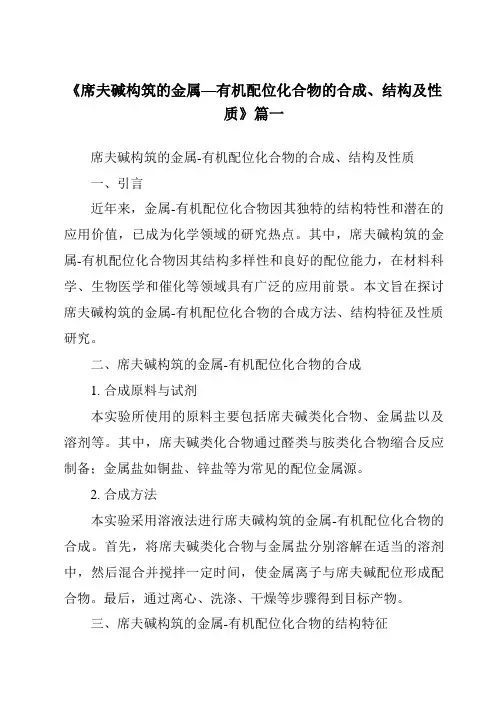
《席夫碱构筑的金属—有机配位化合物的合成、结构及性质》篇一席夫碱构筑的金属-有机配位化合物的合成、结构及性质一、引言近年来,金属-有机配位化合物因其独特的结构特性和潜在的应用价值,已成为化学领域的研究热点。
其中,席夫碱构筑的金属-有机配位化合物因其结构多样性和良好的配位能力,在材料科学、生物医学和催化等领域具有广泛的应用前景。
本文旨在探讨席夫碱构筑的金属-有机配位化合物的合成方法、结构特征及性质研究。
二、席夫碱构筑的金属-有机配位化合物的合成1. 合成原料与试剂本实验所使用的原料主要包括席夫碱类化合物、金属盐以及溶剂等。
其中,席夫碱类化合物通过醛类与胺类化合物缩合反应制备;金属盐如铜盐、锌盐等为常见的配位金属源。
2. 合成方法本实验采用溶液法进行席夫碱构筑的金属-有机配位化合物的合成。
首先,将席夫碱类化合物与金属盐分别溶解在适当的溶剂中,然后混合并搅拌一定时间,使金属离子与席夫碱配位形成配合物。
最后,通过离心、洗涤、干燥等步骤得到目标产物。
三、席夫碱构筑的金属-有机配位化合物的结构特征1. 结构类型席夫碱构筑的金属-有机配位化合物具有多种结构类型,如一维链状、二维网状和三维框架结构等。
这些结构类型与金属离子、席夫碱配体的种类及配位方式密切相关。
2. 晶体结构分析通过X射线单晶衍射技术,可以详细分析席夫碱构筑的金属-有机配位化合物的晶体结构。
从晶体结构中可以观察到金属离子与席夫碱配体之间的配位键、氢键等相互作用,以及化合物的空间排列方式。
四、席夫碱构筑的金属-有机配位化合物的性质研究1. 光学性质席夫碱构筑的金属-有机配位化合物往往具有优异的光学性质,如发光、荧光等。
这些光学性质与化合物的晶体结构、能级分布等密切相关,可以应用于光电材料、荧光探针等领域。
2. 磁学性质某些席夫碱构筑的金属-有机配位化合物具有磁学性质,如铁磁性、反铁磁性等。
这些磁学性质与金属离子的电子排布、配体的电子云密度等有关,可以应用于磁性材料、催化剂等领域。
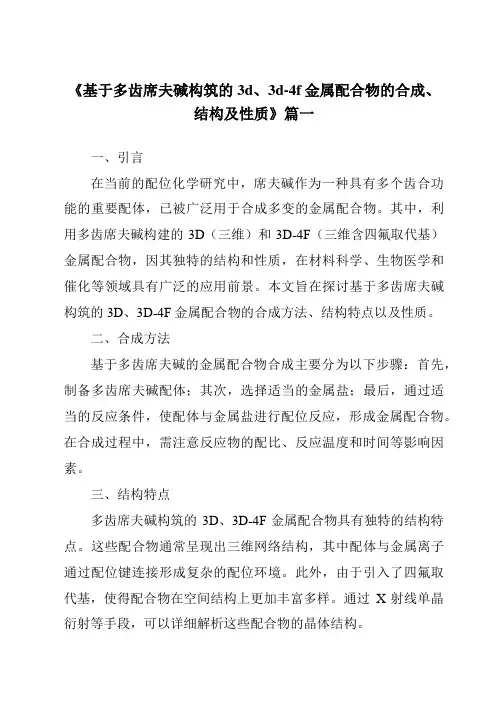
《基于多齿席夫碱构筑的3d、3d-4f金属配合物的合成、结构及性质》篇一一、引言在当前的配位化学研究中,席夫碱作为一种具有多个齿合功能的重要配体,已被广泛用于合成多变的金属配合物。
其中,利用多齿席夫碱构建的3D(三维)和3D-4F(三维含四氟取代基)金属配合物,因其独特的结构和性质,在材料科学、生物医学和催化等领域具有广泛的应用前景。
本文旨在探讨基于多齿席夫碱构筑的3D、3D-4F金属配合物的合成方法、结构特点以及性质。
二、合成方法基于多齿席夫碱的金属配合物合成主要分为以下步骤:首先,制备多齿席夫碱配体;其次,选择适当的金属盐;最后,通过适当的反应条件,使配体与金属盐进行配位反应,形成金属配合物。
在合成过程中,需注意反应物的配比、反应温度和时间等影响因素。
三、结构特点多齿席夫碱构筑的3D、3D-4F金属配合物具有独特的结构特点。
这些配合物通常呈现出三维网络结构,其中配体与金属离子通过配位键连接形成复杂的配位环境。
此外,由于引入了四氟取代基,使得配合物在空间结构上更加丰富多样。
通过X射线单晶衍射等手段,可以详细解析这些配合物的晶体结构。
四、性质研究1. 光学性质:多齿席夫碱构筑的金属配合物往往具有优异的光学性质,如较强的荧光性能。
这些性质使得它们在荧光探针、生物成像等领域具有潜在应用价值。
2. 磁学性质:部分金属配合物具有明显的磁学性质,如顺磁性或抗磁性。
这些性质使得它们在磁性材料和磁学研究中具有应用价值。
3. 催化性质:某些金属配合物具有优异的催化性能,可用于催化有机反应、光催化反应等。
此外,由于引入了四氟取代基,使得这些配合物在含氟有机化合物的合成中具有特殊的应用价值。
4. 热稳定性:通过热重分析等手段,可以研究金属配合物的热稳定性。
这些数据对于评估材料的实际应用性能具有重要意义。
五、结论基于多齿席夫碱构筑的3D、3D-4F金属配合物具有独特的结构和性质,为材料科学、生物医学和催化等领域提供了新的研究方向。

《席夫碱构筑的金属—有机配位化合物的合成、结构及性质》篇一席夫碱构筑的金属-有机配位化合物的合成、结构及性质研究摘要本篇论文以席夫碱为构建基础,着重探讨了一系列金属-有机配位化合物的合成、结构及性质。
通过精心设计的合成策略,我们成功合成了一系列具有独特结构和性质的金属-有机配位化合物,并对它们的合成过程、结构特征以及性质进行了深入的研究和讨论。
一、引言近年来,金属-有机配位化合物因其独特的结构和性质在材料科学、生物医学和催化等领域得到了广泛的应用。
席夫碱作为一种重要的配体,具有丰富的配位模式和良好的配位能力,是构建金属-有机配位化合物的理想选择。
因此,本研究以席夫碱为构建基础,探讨其与金属离子的配位行为,以期为金属-有机配位化合物的设计和应用提供新的思路。
二、实验部分1. 合成方法我们采用不同的金属盐和席夫碱进行反应,通过控制反应条件(如温度、时间、溶剂等),成功合成了一系列金属-有机配位化合物。
具体合成步骤如下:首先,制备席夫碱配体;然后,将金属盐与席夫碱在适当的溶剂中进行反应,得到目标产物。
2. 结构表征利用X射线单晶衍射、X射线粉末衍射、红外光谱等手段对合成的金属-有机配位化合物进行结构表征。
结果表明,这些化合物具有独特的结构和良好的结晶度。
三、结果与讨论1. 结构分析通过X射线单晶衍射分析,我们得到了金属-有机配位化合物的详细结构信息。
结果表明,这些化合物具有多样的配位模式和空间构型,其中金属离子与席夫碱配体之间形成了稳定的配位键。
此外,化合物中还存在氢键、π-π相互作用等非共价相互作用,进一步稳定了化合物的结构。
2. 性质研究我们对合成的金属-有机配位化合物进行了性质研究。
首先,通过热重分析研究了化合物的热稳定性。
结果表明,这些化合物具有较高的热稳定性,能够在较高的温度下保持结构稳定。
其次,我们研究了化合物在催化、荧光、磁性等方面的性质。
结果表明,这些化合物在催化领域具有潜在的应用价值,同时部分化合物还具有荧光和磁性等特殊性质。
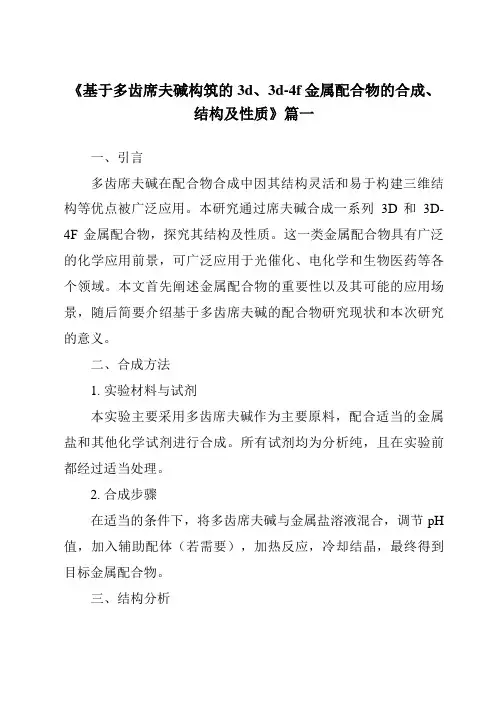
《基于多齿席夫碱构筑的3d、3d-4f金属配合物的合成、结构及性质》篇一一、引言多齿席夫碱在配合物合成中因其结构灵活和易于构建三维结构等优点被广泛应用。
本研究通过席夫碱合成一系列3D和3D-4F金属配合物,探究其结构及性质。
这一类金属配合物具有广泛的化学应用前景,可广泛应用于光催化、电化学和生物医药等各个领域。
本文首先阐述金属配合物的重要性以及其可能的应用场景,随后简要介绍基于多齿席夫碱的配合物研究现状和本次研究的意义。
二、合成方法1. 实验材料与试剂本实验主要采用多齿席夫碱作为主要原料,配合适当的金属盐和其他化学试剂进行合成。
所有试剂均为分析纯,且在实验前都经过适当处理。
2. 合成步骤在适当的条件下,将多齿席夫碱与金属盐溶液混合,调节pH 值,加入辅助配体(若需要),加热反应,冷却结晶,最终得到目标金属配合物。
三、结构分析通过X射线单晶衍射、元素分析等手段对合成的金属配合物进行结构分析。
X射线单晶衍射结果表明,这些金属配合物具有三维或三维四氟化物(3D-4F)结构。
元素分析则进一步验证了金属配合物的组成。
四、性质研究1. 光学性质通过紫外-可见光谱和荧光光谱等手段研究金属配合物的光学性质。
结果表明,这些金属配合物具有良好的光吸收性能和荧光性能,可应用于光催化、光电材料等领域。
2. 电化学性质采用循环伏安法等电化学方法研究金属配合物的电化学性质。
结果表明,这些金属配合物具有良好的电化学性能,可应用于电化学传感器、电池材料等领域。
3. 生物活性通过生物活性测试,发现这些金属配合物具有良好的抗菌、抗肿瘤等生物活性,为生物医药领域的应用提供了可能性。
五、结论本文通过多齿席夫碱合成了一系列3D和3D-4F金属配合物,并通过X射线单晶衍射、元素分析等方法对其结构进行了详细研究。
同时,对其光学性质、电化学性质和生物活性进行了探究。
这些研究结果表明,基于多齿席夫碱的金属配合物具有广泛的应用前景,特别是在光催化、电化学和生物医药等领域。
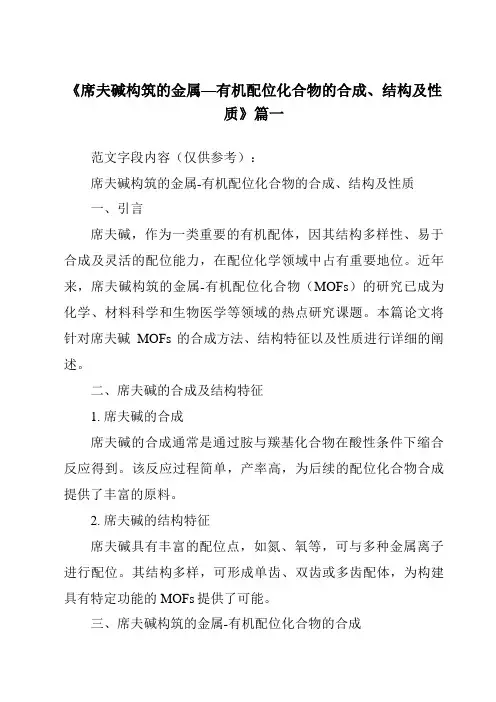
《席夫碱构筑的金属—有机配位化合物的合成、结构及性质》篇一范文字段内容(仅供参考):席夫碱构筑的金属-有机配位化合物的合成、结构及性质一、引言席夫碱,作为一类重要的有机配体,因其结构多样性、易于合成及灵活的配位能力,在配位化学领域中占有重要地位。
近年来,席夫碱构筑的金属-有机配位化合物(MOFs)的研究已成为化学、材料科学和生物医学等领域的热点研究课题。
本篇论文将针对席夫碱MOFs的合成方法、结构特征以及性质进行详细的阐述。
二、席夫碱的合成及结构特征1. 席夫碱的合成席夫碱的合成通常是通过胺与羰基化合物在酸性条件下缩合反应得到。
该反应过程简单,产率高,为后续的配位化合物合成提供了丰富的原料。
2. 席夫碱的结构特征席夫碱具有丰富的配位点,如氮、氧等,可与多种金属离子进行配位。
其结构多样,可形成单齿、双齿或多齿配体,为构建具有特定功能的MOFs提供了可能。
三、席夫碱构筑的金属-有机配位化合物的合成1. 合成方法席夫碱MOFs的合成方法主要包括溶液法、溶剂热法、微波辅助法等。
其中,溶液法是最常用的方法,通过将金属盐和席夫碱在适当溶剂中混合,控制反应条件,得到目标MOFs。
2. 合成实例以某一种席夫碱和铜离子为例,详细介绍MOFs的合成过程。
首先,将铜盐和席夫碱溶解在适当的溶剂中,加热搅拌,待溶液变为澄清后,继续反应一段时间,得到晶体。
通过X射线单晶衍射等技术对晶体进行表征,确认其结构和纯度。
四、席夫碱构筑的金属-有机配位化合物的结构特征1. 拓扑结构席夫碱MOFs具有丰富的拓扑结构,包括一维链状、二维网状、三维框架等。
这些结构使得MOFs具有独特的物理化学性质。
2. 空间构型通过X射线单晶衍射等技术,可以确定MOFs的空间构型。
这些构型对于理解MOFs的性质及其应用具有重要意义。
五、席夫碱构筑的金属-有机配位化合物的性质1. 光学性质席夫碱MOFs具有优异的光学性质,如荧光、磷光等。
这些性质使得MOFs在光电器件、生物探针等领域具有潜在的应用价值。
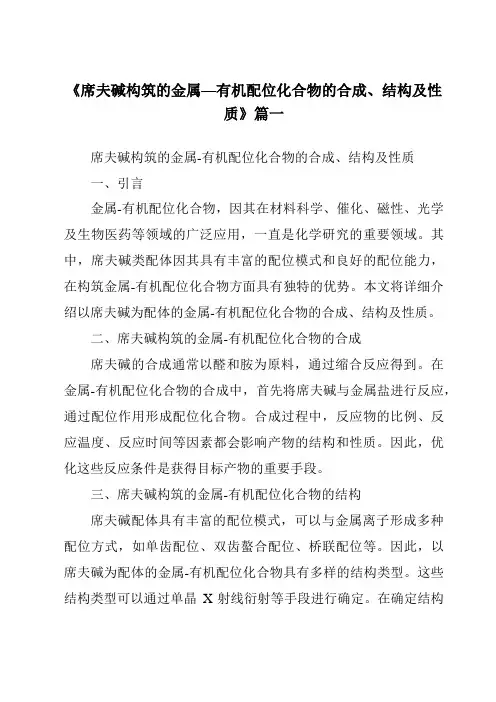
《席夫碱构筑的金属—有机配位化合物的合成、结构及性质》篇一席夫碱构筑的金属-有机配位化合物的合成、结构及性质一、引言金属-有机配位化合物,因其在材料科学、催化、磁性、光学及生物医药等领域的广泛应用,一直是化学研究的重要领域。
其中,席夫碱类配体因其具有丰富的配位模式和良好的配位能力,在构筑金属-有机配位化合物方面具有独特的优势。
本文将详细介绍以席夫碱为配体的金属-有机配位化合物的合成、结构及性质。
二、席夫碱构筑的金属-有机配位化合物的合成席夫碱的合成通常以醛和胺为原料,通过缩合反应得到。
在金属-有机配位化合物的合成中,首先将席夫碱与金属盐进行反应,通过配位作用形成配位化合物。
合成过程中,反应物的比例、反应温度、反应时间等因素都会影响产物的结构和性质。
因此,优化这些反应条件是获得目标产物的重要手段。
三、席夫碱构筑的金属-有机配位化合物的结构席夫碱配体具有丰富的配位模式,可以与金属离子形成多种配位方式,如单齿配位、双齿螯合配位、桥联配位等。
因此,以席夫碱为配体的金属-有机配位化合物具有多样的结构类型。
这些结构类型可以通过单晶X射线衍射等手段进行确定。
在确定结构的过程中,需要关注配体的配位模式、金属离子的配位数、化合物的空间构型等关键信息。
四、席夫碱构筑的金属-有机配位化合物的性质1. 光学性质:由于席夫碱及其金属-有机配位化合物中存在共轭体系,因此它们往往具有优异的光学性质,如发光、光致变色等。
这些性质使其在光学材料、光电设备等领域具有潜在的应用价值。
2. 磁学性质:某些金属-有机配位化合物具有特殊的磁学性质,如单分子磁体、磁性转换等。
这些性质使其在磁性材料、磁存储等领域具有应用前景。
3. 催化性质:由于金属-有机配位化合物中存在活性金属中心和丰富的配体结构,因此它们往往具有良好的催化性能。
例如,它们可以作为氧化还原催化剂、酸碱催化剂等。
4. 生物活性:部分金属-有机配位化合物具有生物活性,可以作为药物或生物探针等应用于生物医药领域。
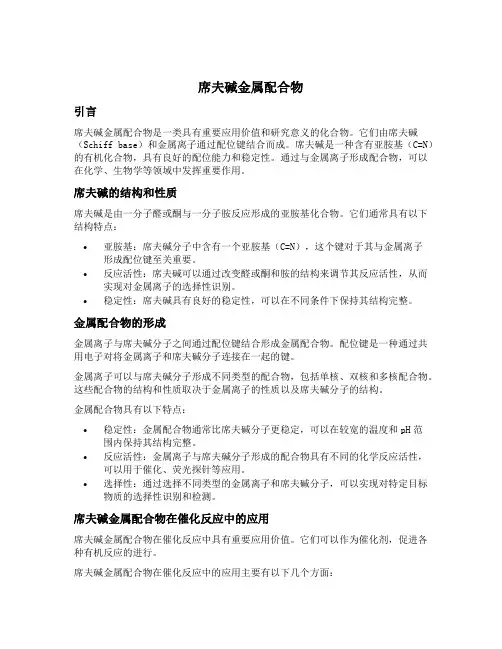
席夫碱金属配合物引言席夫碱金属配合物是一类具有重要应用价值和研究意义的化合物。
它们由席夫碱(Schiff base)和金属离子通过配位键结合而成。
席夫碱是一种含有亚胺基(C=N)的有机化合物,具有良好的配位能力和稳定性。
通过与金属离子形成配合物,可以在化学、生物学等领域中发挥重要作用。
席夫碱的结构和性质席夫碱是由一分子醛或酮与一分子胺反应形成的亚胺基化合物。
它们通常具有以下结构特点:•亚胺基:席夫碱分子中含有一个亚胺基(C=N),这个键对于其与金属离子形成配位键至关重要。
•反应活性:席夫碱可以通过改变醛或酮和胺的结构来调节其反应活性,从而实现对金属离子的选择性识别。
•稳定性:席夫碱具有良好的稳定性,可以在不同条件下保持其结构完整。
金属配合物的形成金属离子与席夫碱分子之间通过配位键结合形成金属配合物。
配位键是一种通过共用电子对将金属离子和席夫碱分子连接在一起的键。
金属离子可以与席夫碱分子形成不同类型的配合物,包括单核、双核和多核配合物。
这些配合物的结构和性质取决于金属离子的性质以及席夫碱分子的结构。
金属配合物具有以下特点:•稳定性:金属配合物通常比席夫碱分子更稳定,可以在较宽的温度和pH范围内保持其结构完整。
•反应活性:金属离子与席夫碱分子形成的配合物具有不同的化学反应活性,可以用于催化、荧光探针等应用。
•选择性:通过选择不同类型的金属离子和席夫碱分子,可以实现对特定目标物质的选择性识别和检测。
席夫碱金属配合物在催化反应中的应用席夫碱金属配合物在催化反应中具有重要应用价值。
它们可以作为催化剂,促进各种有机反应的进行。
席夫碱金属配合物在催化反应中的应用主要有以下几个方面:1.氧化反应:席夫碱金属配合物可以作为氧化剂,促进有机物的氧化反应。
例如,铜配合物可以催化苯酚的氧化反应,生成对苯二酚。
2.还原反应:席夫碱金属配合物也可以作为还原剂,促进有机物的还原反应。
例如,铁配合物可以催化芳香醛的还原反应,生成相应的醇。
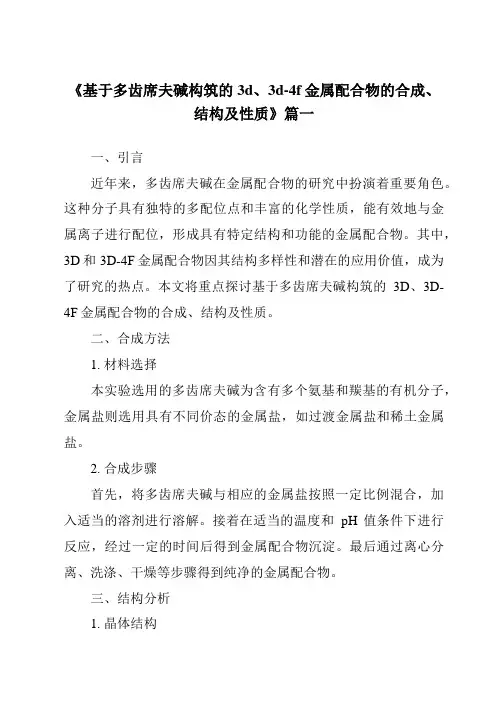
《基于多齿席夫碱构筑的3d、3d-4f金属配合物的合成、结构及性质》篇一一、引言近年来,多齿席夫碱在金属配合物的研究中扮演着重要角色。
这种分子具有独特的多配位点和丰富的化学性质,能有效地与金属离子进行配位,形成具有特定结构和功能的金属配合物。
其中,3D和3D-4F金属配合物因其结构多样性和潜在的应用价值,成为了研究的热点。
本文将重点探讨基于多齿席夫碱构筑的3D、3D-4F金属配合物的合成、结构及性质。
二、合成方法1. 材料选择本实验选用的多齿席夫碱为含有多个氨基和羰基的有机分子,金属盐则选用具有不同价态的金属盐,如过渡金属盐和稀土金属盐。
2. 合成步骤首先,将多齿席夫碱与相应的金属盐按照一定比例混合,加入适当的溶剂进行溶解。
接着在适当的温度和pH值条件下进行反应,经过一定的时间后得到金属配合物沉淀。
最后通过离心分离、洗涤、干燥等步骤得到纯净的金属配合物。
三、结构分析1. 晶体结构通过X射线单晶衍射技术对合成的金属配合物进行晶体结构分析。
结果表明,多齿席夫碱与金属离子形成了具有3D或3D-4F结构的金属配合物。
其中,金属离子与席夫碱的配位点形成了配位键,使得分子之间相互连接,形成了三维的网络结构。
2. 结构特点根据单晶衍射数据,可以确定金属配合物的具体结构。
其中,多齿席夫碱的配位点与金属离子形成了稳定的配位键,使得金属配合物具有较高的稳定性。
此外,由于多齿席夫碱的多个配位点与金属离子的配位作用,使得金属配合物的结构具有多样性。
四、性质研究1. 光学性质金属配合物在紫外-可见光谱中表现出明显的吸收峰,表明其具有较好的光学性质。
通过测定吸收峰的位置和强度,可以判断出金属配合物的能级结构和电子跃迁情况。
此外,金属配合物还表现出较好的荧光性质,可用于制备荧光材料。
2. 磁学性质对于含有过渡金属的金属配合物,其磁学性质也是研究的重要方面。
通过测量金属配合物的磁化率和磁化强度等参数,可以了解其磁学性质。
结果表明,金属配合物具有较好的磁学性能,可用于制备磁性材料。
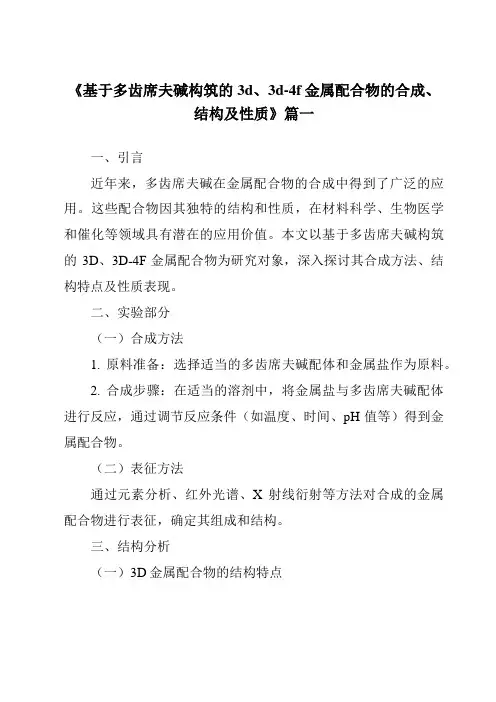
《基于多齿席夫碱构筑的3d、3d-4f金属配合物的合成、结构及性质》篇一一、引言近年来,多齿席夫碱在金属配合物的合成中得到了广泛的应用。
这些配合物因其独特的结构和性质,在材料科学、生物医学和催化等领域具有潜在的应用价值。
本文以基于多齿席夫碱构筑的3D、3D-4F金属配合物为研究对象,深入探讨其合成方法、结构特点及性质表现。
二、实验部分(一)合成方法1. 原料准备:选择适当的多齿席夫碱配体和金属盐作为原料。
2. 合成步骤:在适当的溶剂中,将金属盐与多齿席夫碱配体进行反应,通过调节反应条件(如温度、时间、pH值等)得到金属配合物。
(二)表征方法通过元素分析、红外光谱、X射线衍射等方法对合成的金属配合物进行表征,确定其组成和结构。
三、结构分析(一)3D金属配合物的结构特点通过X射线衍射等手段,我们发现3D金属配合物具有三维网状结构,配体与金属离子之间通过配位键相连,形成具有特定空间构型的网络结构。
(二)3D-4F金属配合物的结构特点3D-4F金属配合物在结构上与3D金属配合物相似,但含有四种不同的氟离子配位环境,这使得其结构更加复杂。
通过精细的X射线衍射分析,我们可以观察到氟离子与金属离子之间的配位关系,以及它们对整体结构的影响。
四、性质研究(一)光学性质3D、3D-4F金属配合物在紫外-可见光谱中表现出明显的吸收峰,表明它们具有优异的光学性质。
通过分析吸收峰的位置和强度,可以了解配体与金属离子之间的电子转移过程。
(二)磁学性质磁学性质研究表明,3D、3D-4F金属配合物具有明显的磁性。
通过测量其磁化率和磁矩,可以了解金属离子之间的相互作用及配体的影响。
(三)催化性质某些3D金属配合物在特定反应中表现出良好的催化活性。
通过研究其催化机理,可以深入了解配合物的结构与性能之间的关系。
此外,还可以尝试通过改变配合物的结构来优化其催化性能。
五、结论本文通过对基于多齿席夫碱构筑的3D、3D-4F金属配合物的合成、结构及性质进行研究,发现这些配合物具有独特的三维网状结构和优异的光学、磁学及催化性质。

席夫碱及其金属配合物的合成及生物活性研究进展一、本文概述席夫碱(Schiff Base)及其金属配合物是一类重要的有机金属化合物,因其独特的结构和性质,在化学、材料科学、生物医学等多个领域具有广泛的应用前景。
本文旨在综述近年来席夫碱及其金属配合物的合成方法、结构特性以及生物活性研究的重要进展。
文章将首先介绍席夫碱的基本概念、合成策略以及结构多样性,然后重点论述席夫碱金属配合物的合成方法、结构表征以及性能调控。
本文还将对席夫碱及其金属配合物在抗菌、抗肿瘤、抗氧化等生物活性方面的研究成果进行详细阐述,以期为未来相关领域的研究提供有益的参考和启示。
二、席夫碱的合成方法席夫碱的合成主要依赖于醛或酮的羰基与胺或氨的氨基之间的缩合反应,也称为亚胺化反应。
这种反应通常在温和的条件下进行,如室温或稍微加热,无需催化剂或仅需少量催化剂。
反应过程中,羰基碳原子与氨基氮原子形成新的碳氮双键,同时生成一分子水。
由于反应过程中涉及到电子的转移和共享,因此反应通常具有较高的选择性和产率。
醛或酮与伯胺的缩合:这是合成席夫碱最常用的方法。
醛或酮与伯胺在适当的溶剂中,通过加热或搅拌,可以高效地生成对应的席夫碱。
这种方法简单易行,产物纯度高,是实验室常用的合成方法。
醛或酮与仲胺的缩合:与伯胺相比,仲胺的氨基活性较低,需要更强烈的条件才能发生缩合反应。
通常需要使用催化剂,如酸性催化剂,以促进反应的进行。
醛或酮与氨的缩合:在这种情况下,氨作为氨基的供体,与醛或酮发生缩合反应。
由于氨的水溶性较高,反应通常在水溶液中进行。
醛或酮与肼的缩合:肼作为一种特殊的胺,可以与醛或酮发生缩合反应,生成含有两个氨基的席夫碱。
这种方法在合成具有特殊功能的席夫碱时非常有用。
席夫碱的合成方法多样,可以根据具体的需求选择合适的原料和反应条件。
由于席夫碱的结构多样性,通过改变原料和反应条件,可以合成出具有各种功能的席夫碱,为后续的金属配合物合成和生物活性研究提供了丰富的物质基础。
《席夫碱构筑的金属—有机配位化合物的合成、结构及性质》篇一席夫碱构筑的金属-有机配位化合物的合成、结构及性质一、引言席夫碱(Schiff base)是一种重要的有机配体,其独特的结构和化学性质使其在配位化学领域具有广泛的应用。
近年来,以席夫碱为构筑单元的金属-有机配位化合物(MOFs)因其具有多样的结构及潜在的物理、化学性质,成为了配位化学领域的研究热点。
本文旨在探讨席夫碱构筑的金属-有机配位化合物的合成、结构及性质。
二、席夫碱构筑的金属-有机配位化合物的合成席夫碱构筑的金属-有机配位化合物的合成通常包括以下步骤:首先,通过醛类与胺类反应生成席夫碱;然后,将席夫碱与金属离子在适当的溶剂中进行配位反应,生成金属-有机配位化合物。
在合成过程中,反应物的比例、反应温度、溶剂种类等因素都会影响产物的结构和性质。
三、席夫碱构筑的金属-有机配位化合物的结构席夫碱构筑的金属-有机配位化合物的结构多种多样,取决于反应物种类、金属离子及合成条件等因素。
一般来说,金属离子与席夫碱配体通过配位键形成多维网络结构,这些网络结构可能是一维链状、二维层状或三维框架结构。
此外,配体间的氢键、π-π堆积等相互作用也可能影响化合物的整体结构。
四、席夫碱构筑的金属-有机配位化合物的性质1. 光学性质:席夫碱构筑的金属-有机配位化合物具有优异的光学性质,如荧光、非线性光学等。
这些性质使其在光电器件、生物成像等领域具有潜在应用价值。
2. 磁学性质:某些金属-有机配位化合物具有显著的磁学性质,如铁磁性、反铁磁性等。
这些性质使其在磁性材料、磁存储器件等领域具有应用前景。
3. 催化性质:金属-有机配位化合物可作为催化剂或催化剂载体,用于有机合成、环境保护等领域。
其催化活性及选择性取决于化合物的结构、金属离子的性质等因素。
4. 吸附性质:某些金属-有机配位化合物具有优异的吸附性能,如对气体、重金属离子等的吸附。
这些性质使其在环境保护、能源领域具有潜在应用价值。
《基于多齿席夫碱构筑的3d、3d-4f金属配合物的合成、结构及性质》篇一一、引言随着材料科学和化学领域的发展,金属配合物因其在不同领域的应用价值,受到了广泛关注。
在众多金属配合物中,由多齿席夫碱构筑的金属配合物因其具有多样的配位方式和优良的化学稳定性而受到特殊重视。
本研究通过设计和合成多齿席夫碱,构建了3D和3D-4F(即包含3D结构和4F元素)的金属配合物,并对其结构及性质进行了深入研究。
二、实验部分(一)多齿席夫碱的合成本实验采用多齿席夫碱作为配体,通过与不同的醛类化合物进行缩合反应,成功合成了多种多齿席夫碱。
具体合成步骤如下:首先,将相应的胺类化合物与醛类化合物在适当的溶剂中加热反应,得到席夫碱中间体;然后,将中间体与多齿配体进行缩合反应,得到多齿席夫碱。
(二)金属配合物的合成将合成的多齿席夫碱与金属盐进行配位反应,得到金属配合物。
具体步骤为:将金属盐溶解在适当的溶剂中,加入多齿席夫碱,在一定温度下反应一段时间后,得到金属配合物。
通过改变金属离子和席夫碱的种类和比例,可以合成出不同结构和性质的金属配合物。
三、结果与讨论(一)金属配合物的结构分析通过X射线单晶衍射技术对合成的金属配合物进行结构分析,发现这些配合物具有3D和3D-4F的结构特点。
其中,3D结构指的是配合物在空间上呈现出三维网络结构;4F则表示配合物中包含了四种不同的氟元素金属离子。
此外,多齿席夫碱的配位方式和金属离子的配位环境也对配合物的结构产生了重要影响。
(二)金属配合物的性质研究1. 光学性质:通过紫外-可见光谱和荧光光谱对金属配合物的光学性质进行研究。
结果表明,这些配合物具有优异的光学性能,可用于光电器件和生物成像等领域。
2. 磁学性质:通过磁化率测量等手段对金属配合物的磁学性质进行研究。
结果表明,这些配合物具有良好的磁学性能,可用于磁性材料和磁存储器件等领域。
3. 催化性质:通过催化实验对金属配合物的催化性质进行研究。
《席夫碱构筑的金属配位化合物的合成、结构及性质研究》篇一一、引言近年来,席夫碱类化合物在配位化学领域得到了广泛的研究。
它们因其独特的结构和多样的配位模式,常被用于构筑各种金属配位化合物。
此类化合物在催化、磁性材料、生物医药等多个领域均有着重要的应用。
因此,研究席夫碱构筑的金属配位化合物的合成、结构及性质具有重要的理论和实践意义。
二、席夫碱构筑的金属配位化合物的合成席夫碱的合成通常以醛和胺为原料,通过缩合反应得到。
在金属配位化合物的合成中,我们选择适当的席夫碱与金属盐进行反应,通过调整反应条件如温度、溶剂、反应时间等,得到目标金属配位化合物。
具体来说,我们以某种特定的席夫碱和铜盐为例,将它们在乙醇溶液中加热回流,得到了一种新型的铜基席夫碱配位化合物。
通过调整反应物比例、改变反应条件等方法,我们可以得到一系列的金属配位化合物。
三、席夫碱构筑的金属配位化合物的结构我们通过X射线单晶衍射技术对合成的金属配位化合物进行了结构分析。
结果表明,这些化合物具有独特的三维网络结构,金属离子与席夫碱的氧、氮原子形成了稳定的配位键。
此外,这些化合物还具有多样的空间构型,如一维链状、二维网状、三维框架等。
这些结构特点使得它们在应用领域具有潜在的价值。
四、席夫碱构筑的金属配位化合物的性质研究1. 催化性质:我们研究了这些金属配位化合物在有机反应中的催化性能。
实验结果表明,它们对某些反应具有较好的催化效果,如酯化反应、环氧化反应等。
这为它们在催化领域的应用提供了可能。
2. 磁学性质:我们对部分金属配位化合物的磁学性质进行了研究。
结果表明,这些化合物具有丰富的磁学行为,如铁磁性、反铁磁性等。
这为它们在磁性材料领域的应用提供了理论依据。
3. 生物活性:我们还研究了这些金属配位化合物对生物分子的作用,如对DNA的切割作用等。
实验结果表明,它们具有一定的生物活性,这为它们在生物医药领域的应用提供了可能。
五、结论本文研究了席夫碱构筑的金属配位化合物的合成、结构及性质。
《基于多齿席夫碱构筑的3d、3d-4f金属配合物的合成、结构及性质》篇一一、引言在当前的配位化学研究中,基于多齿席夫碱构筑的金属配合物,尤其是具有复杂空间结构与功能的金属配合物,正日益成为化学家关注的焦点。
多齿席夫碱不仅可以通过自身的配位能力与金属离子形成稳定的配合物,而且可以构筑出具有独特性质的3D、3D-4F(即包含第三周期过渡金属和镧系或锕系元素)金属配合物。
本文将详细介绍此类配合物的合成方法、晶体结构及其相关性质。
二、实验部分(一)实验材料与仪器1. 实验材料:金属盐、多齿席夫碱、有机溶剂等。
2. 仪器:分光光度计、X射线衍射仪、元素分析仪等。
(二)金属配合物的合成采用常规的配位化学反应方法,将金属盐与多齿席夫碱在适当的溶剂中反应,得到目标金属配合物。
具体步骤如下:1. 准备所需试剂和溶剂。
2. 将金属盐和多齿席夫碱按照一定比例混合在溶剂中。
3. 在一定的温度和压力下进行反应,得到目标金属配合物。
(三)晶体结构分析通过X射线衍射技术对合成的金属配合物进行晶体结构分析,得到其空间结构和配位模式。
三、结果与讨论(一)晶体结构描述通过X射线衍射分析,我们得到了目标金属配合物的晶体结构。
该配合物具有3D或3D-4F的复杂空间结构,其中多齿席夫碱以一定的配位模式与金属离子相连,形成了多维度的配位网络。
同时,金属离子之间的相互作用以及与其他分子的相互作用也为这种结构的形成提供了可能。
具体配位模式及空间结构特点因具体化合物而异,需根据实验结果进行详细描述。
(二)合成条件对结构的影响合成条件对金属配合物的结构具有重要影响。
例如,反应温度、溶剂种类和浓度等都会影响金属配合物的形成和结构。
在实验过程中,我们尝试了不同的合成条件,得到了不同结构的金属配合物。
通过对这些条件的优化,我们可以更好地控制金属配合物的结构和性质。
(三)金属配合物的性质研究1. 光谱性质:通过分光光度计等仪器,研究金属配合物的光谱性质,如紫外-可见吸收光谱、荧光光谱等。